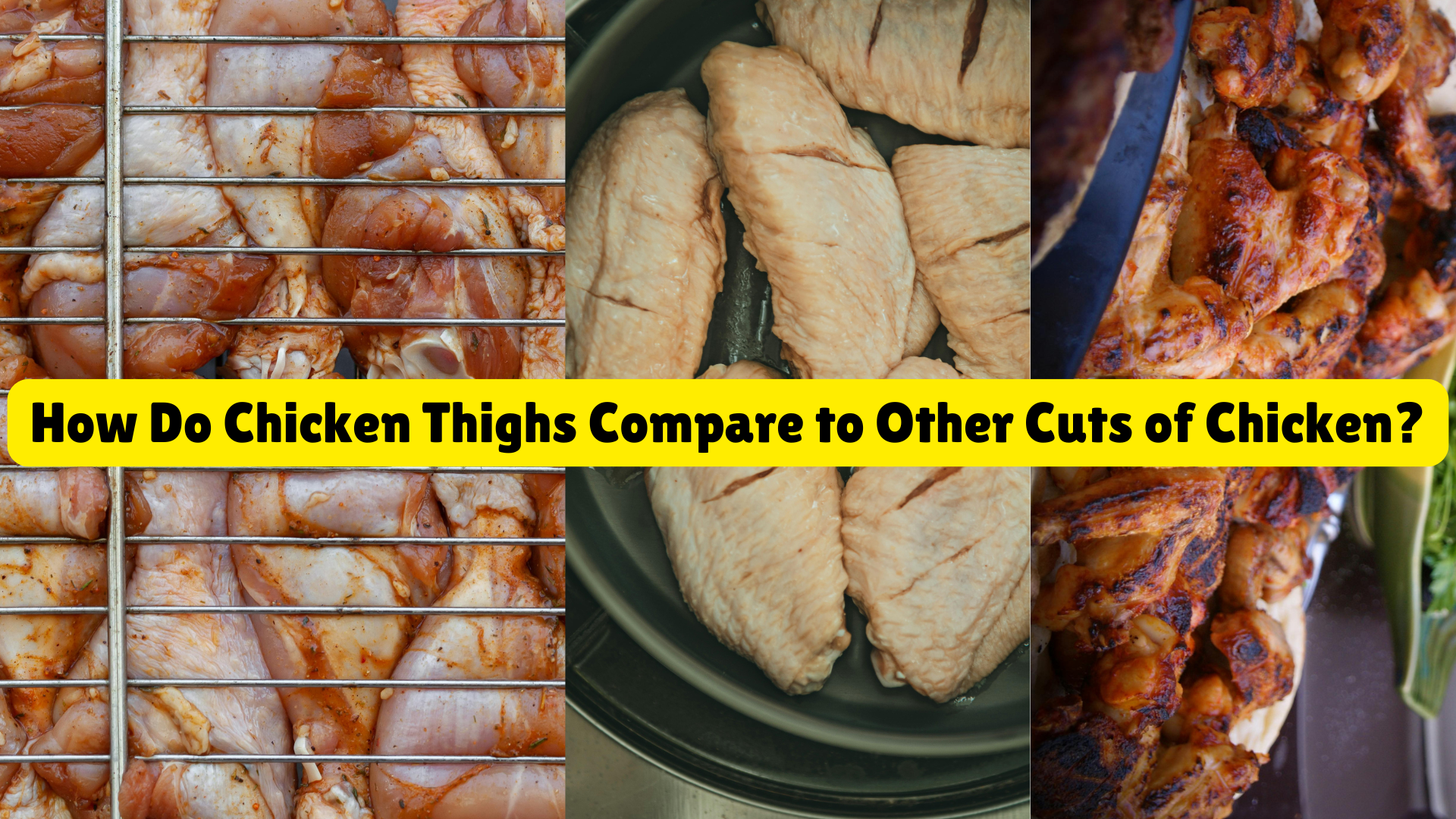But how many chicken thigh calories are you actually consuming? And should you be concerned about the calories if you’re watching your diet? In this post you will learn more on the subject of chicken thigh calories, the nutritional values of this popular meat cut, and how to enjoy your chicken thighs without having to give up on all your fitness goals.
There are different ways of cooking chicken, and the calories are calculated accordingly. Most varieties have 177 calories in 100 grams of chicken thigh. Chicken thigh calories are a favorite at many events as they are richly juicy and very good in taste. It can help you make informed decisions about your diet. Their calories depend on how you make it, whether you are frying it uphill or steaming it uphill, or you are making it in some other way.
What Are Chicken Thighs?
Chicken thighs are the upper part of the chicken leg; considered the most prized of chicken meat, it is naturally more flavorful than chicken breast and other parts of the chicken. They are sold in various forms:
- Bone-in or boneless
- Skin-on or skinless
- Raw or cooked
The number of chicken thigh calories depends mostly on their ingredients and the cooking method used.
Regardless of whether you want to gain, lose or find out how many calories are there in chicken thighs, this article will help you and you can also visit on this site for more information: How Many Calories in Chicken? Breast, Thigh, Wing, and More
What’s the Calorie Count in Chicken Thighs?
Let’s start with the basics. How many calories are in a chicken thigh? Calories can also be different if you are consuming skin-on or skin-off chicken thighs or if you are consuming a cooked or raw chicken thigh. But here’s a quick breakdown to help you understand the general calorie content:
- Skinless, Boneless Chicken Thigh (100 grams)
- Calories: About 165-200 Calories
- The chicken thighs of deboned and without the skin are a little leaner compared to those with skin intact but they are great sources of protein as well as other fats.
- Skin-On, Bone-In Chicken Thigh (100 grams)
- Calories: About 220-250 Calories
- Of all subordinate parts of poultry, including skin and bone, chicken thighs are naturally richer as they contain the fat from the skin and bone-in. This cut is slightly butter higher making it richer in taste as compared to the previously mentioned stew.
- Whole Chicken Thigh (1 medium, about 3 oz/serving or 85 grams/serving)
- Calories: Around 200-250 calories for a skin-on, bone-in thigh
- It’ll be very tricky to state how many total calories of this item are present, necessarily depending on how big the thigh is and if it is cooked or uncooked.
I have listed these calorie ranges only as approximations. The kind of preparation you use when cooking your chicken thighs also affects the number of calories that are present. Pan-frying, broiling, roasting, or grilling your chicken thighs will keep the calorie content low compared to frying the chicken pieces in oil or butter.

How Do Chicken Thighs Compare to Other Cuts of Chicken?
You could now be asking yourself where chicken thigh calories sit when it comes to other parts of chicken, such as breasts or wings. Well, let’s break it down:
- Chicken Breast (Skinless, Boneless, 100 grams)
-
- Calories: 165 calories
- Breast meat has less fat and contains fewer calories than thigh portions. They are commonly considered the ultimate option for those who would like to get slimming, low-calorie, high-protein nutrition.
- Chicken Wings (Skin-on, 100 grams)
- Calories: 200-250 calories
- Chicken wings have a similar calorie count to chicken thighs, but much of the fat comes from the skin. If you remove the skin, the calorie count drops significantly.
- Chicken Drumsticks (Skin-on, 100 grams)
- Calories: 180-200 calories
- The other part of chicken meat is the chicken drumsticks, and comparatively, it is low in calorie rates but contains some fat and protein content.
What is more, you can note that chicken thighs can be classified as foods of moderate calorThey’ree. They contain a few more calories than chicken breast, but they possess better taste and fat, which makes them perfect for many people.
Nutritional Breakdown of Chicken Thighs
In addition to calories, the thighs of chicken are rich in a number of important nutrients that benefit your diet. Here’s a quick list of the nutritional content of a skinless, boneless chicken thigh (100 grams):
- Protein: 22-24 grams
- Chicken thighs can be considered the main source of premium quality protein required for muscle build-up, repair, growth, and many more functions in the body.
- Fat: 9-12 grams
- The fat content is somewhat higher than you’d find in your chicken breast, and this is why chicken thighs contain more moisture and are tastier. Many of the fats are unsaturated, which is beneficial to the body, unlike the saturated fats that are so common today.
Vitamins and Minerals:
The piece of chicken, namely chicken thighs, contains vitamins B6 and B12, that is crucial for the functioning of the brain, energy-producing, and red blood cell producing.
It also has minerals like zinc, phosphorus, and selenium that are involved in carving the immune, bone, and cell movement.
Part of the extra fat content is calories, so chicken thighs are specifically useful for the amounts of energy needed for the physically active or for individuals whose caloric intake is higher.

Health Benefits of Chicken Thighs
While chicken thigh calories are a bit higher than other cuts, they offer several health benefits that make them worth considering for your meals:
- High in Protein for Building the Muscle
Muscle tissue needs protein to build, and there are moderate levels of protein in chicken thighs. They then make chicken thighs the best meal for athletes, bodybuilders, or anyone who wants to gain muscles.
- Provides Healthy Fats
While light muscles are found in chicken breasts as compared to chicken thighs, the latter are enriched with unsaturated fats of monounsaturated fats required for the heart. It also calms hunger quickly as well as helps for longer food holding, hence making the chicken thighs a nutritious meal choice.
- Good for Weight Control if taken moderately
The reason why the nutrient profile of chicken thighs has a higher amount of calorie content is that it is not unhealthy. Taking protein, fat, and micronutrients to accompany the carbs will keep you satiated, and meals from later in the day may not leave you overeating.
In case, you are not aspiring to achieve weight loss but crave a calorie-controlled diet, chicken thighs can provide the right nutrients that will ensure your metabolism remains recipes up all day.
- Versatile and Easy to Cook
Chicken thighs can be used in many preparations – you can grill, roast, bake, or even slow-cook the chicken thigh. At that, it is possible to add your favorite seasonings or marinades to the dish and make them the perfect choice for a tasty meal.

How to Prepare Chicken Thighs to Keep the Calories in Check
If you’re mindful you’re calories in chicken thighs but don’t want to don’tfice flavor, there are ways to cook them without overloading your meal with excess calories:
- Grill as opposed to Deep Fry
Cooking chicken thighs in oil or breading is also unhealthy as it incorporates additional pounds. However, one should fry them or grill or barbecue them with a bit of olive oil or cooking spray for them to be light. Of equal importance, while cooking you can use a wire rack in order to drain the fat.
- Reduce the Skin for a Diet Option
If you are interested in the nutrient contents and want to cut down on the calorie contents, you can decide to remove the skin from your chicken thighs. Fat and calories are deposited in the skin, and since most of the thighs are skinless, most of the calorie content will be eliminated.
- Choose the grilling method or air-frying.
Methods like grilling/ air frying are very effective for preparing chicken thighs; you get an extra taste without having to incorporate more calories. Unlike the conventional deep-frying techniques, both methods enable the fat to drop off and the calorie content to be kept down while achieving that extra crunch on the skin that makes chicken thighs so appealing.
- Watch Your Portion Sizes
Although chicken thighs are relatively fattening, they do not necessarily have to be left out from the kinds of foods that will be taken in a balanced diet plan. As long as you stay conscious of your portion control, meaning consuming only one or two thighs for a meal if, let’s say, restrictions are 500-800 calories. You can have lean protein and good fat without becoming inundated with calories.

How Many Chicken Thighs Should You Eat?
The answer to this really depends on your personal goals and nutritional needs. Not only sticking to the skin, but for someone who is attempting to put on weight or, at the very least, make no loss, two to three chicken thighs, depending on their size, are a nice package of nutrition from calories, protein, and fats.
If you want to shed some pounds, you can eat chicken thighs, although skinned and boned ones, if you accompany them with vegetables or a low-energy accompaniment. Also, it is advisable to ensure that you eat your chicken alongside a side order of good carbohydrates, such as quinoa, brown rice, or sweet potatoes.
The Last Word on the Calories of Chicken Thigh
In conclusion, chicken thighs are versatile with a delicious taste, high protein, and good fat; they are loved by anyone with intent on following a specific diet plan. As they are known to contain a lot of calories than chicken breasts, they are full of nutrients that could help build muscles and lose some calories, among other benefits. If you are going to prefer baking, grilling or roasting, you can have your chicken thighs without increasing your calorie level.
The next time you shop at the store for chicken, do not rule out this delicious and handy part of the bird. No matter if you’re defrosting, you’re od for dinner, or preparing meals in advance for the whole week, chicken thighs may be a part of a healthy diet plan.
Quick FAQ: Chicken Thigh Calories
Q: Are chicken thighs healthier than chicken breasts?
A: Dark meat, which is chicken thighs, contains more fats than white meat; although it also includes more calories, it has more taste and nutrients. It’s a cereal It’suct; it can be classified as relatively healthy if eaten in large portions, especially depending on your fitness goals.
Q: How many chicken thighs should I eat to get enough protein?
A: It should be understood that approximately 22-24 grams of proteins may be obtained from one skinless, boneless chicken thigh (weighing 100 grams). Depending on your needs, 2-3 thighs can easily give a solid protein source for a meal.
Q: How can I reduce the chicken thighs calories?
A: To reduce the level of chicken thigh calories, the skin should be removed, and instead of deep frying, the thighs should be grilled, broiled, or roasted. Other even simpler operations involve eradicating unnecessary fat to decrease the total energy of the food.
You can also visit :How Many Calories Does Pilates Burn l A Perfect Guide To Your Fitness




